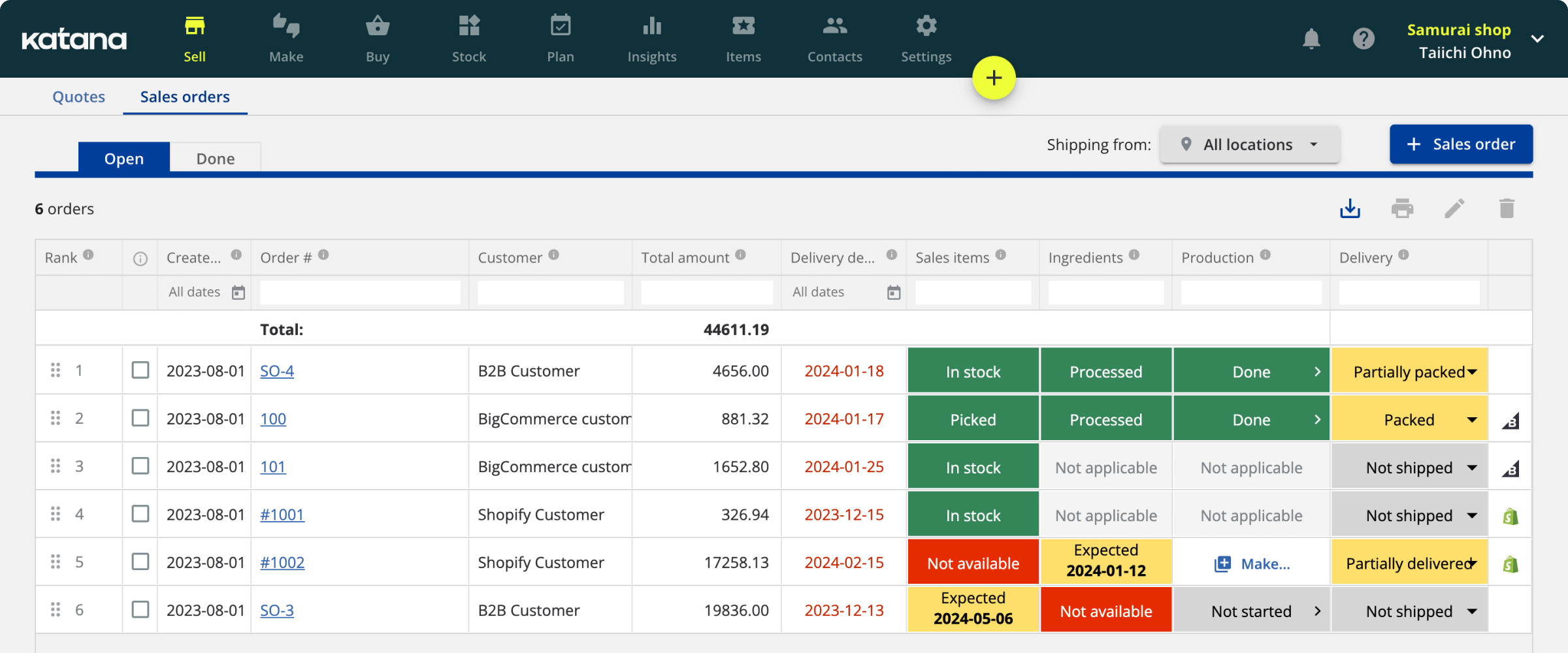Scale your business with inventory optimization software
Streamlining your inventory management processes is easy with the proper inventory optimization solution. Keep track of all moving parts, including purchases, sales, and inventory while maintaining ideal stock levels and growing your business.
Optimized inventory for improved bottom line
Inflated carrying costs due to slow-moving excess inventory are one of the largest monetary waste businesses have to deal with. At the other end of the scale, stockouts make you lose out on sales and erode trust in your company. Inventory optimization software ensures optimal inventory levels for minimal waste and maximum profits.
Balancing your inventory and associated costs
Inventory optimization solutions help businesses balance their stock levels and associated costs by analyzing demand, lead times, and carrying costs to determine the most optimal inventory levels.
Katana’s inventory optimization software helps you with:
- Setting reorder points for low stock thresholds so you never run out of popular items
- End-to-end stock management for managing product variations/SKUs and materials in a single platform
- Avoiding stockouts while minimizing inventory carrying costs
Optimizing workflows throughout your business
Stock optimization software helps streamline workflows throughout your business by improving inventory management, reducing waste, and increasing efficiency.
Katana’s stock optimization software gives you the tools to:
- Quickly receive and count stock using barcode scanners
- Effortlessly manage inventory across all your locations and sales channels
- Make data-driven decisions with valuable insights into inventory levels, usage, and demand patterns

Integrate your favorite business tools for centralized management
If you’re already set up with tools to manage your business that you don’t want to part ways with, then no worries. Katana easily integrates with the best tools on the market to give you the smoothest manufacturing process.
Katana’s inventory optimization software lets users:
- Integrate online sales platforms such as Shopify, WooCommerce, and BigCommerce
- Integrate accounting tools such as QuickBooks Online and Xero
- Create customized workflows with Katana’s open API
Integrating Katana with the tools you need and love
Connect Katana with native integrations or create your own workflows via API
Choose from a range of e-commerce, accounting, CRM, reporting, and automation integrations to streamline inventory management and optimize your entire business. Take a gander at Katana’s growing list of integrations to learn more.
Katana provides us with all the features for manufacturing order management and can track inventory usage and incorporate our sales order tracking into Katana.”
Mikhail MooreChief Executive Office (CEO) at Vitacore Industries
It’s great to be able to see where inventory faults happen and being able to fulfill orders and where the turnaround happens.”
Alaina Oehrlein
Production Lead at Essence One
Katana accurately keeps stock of assemblies and ingredients so that I can plan production and get instant feedback on whether we enough resources in stock.”
Kelly Costello
Chief Executive Officer (CEO) at Puppy Cake
We also wanted an accurate inventory system for batch planning, warehousing, and sales. Katana fulfills all our needs in a simple, easy way, unlike other inventory solutions.”
Irah Vet
Founder and Production Manager at Hornby Organic
Inventory optimization software FAQs
Firstly, it is important to understand the needs of the business and any specific requirements that need to be met regarding stocking levels and delivery times. Once this has been established, the next step is to analyze current inventory levels and determine what inventory management system would best suit those needs.
The most common approach is to use a combination of manual processes, like physical stocktaking, and computerized software solutions. Manual processes can help improve accuracy, reduce costs, and increase speed. However, they are time-consuming if multiple locations are involved, or many stock items must be tracked. Computerized systems offer more flexibility by allowing for automatic ordering based on minimum stocks, monitoring stock levels, and easy transfer of data to other departments.
Once an inventory system is in place, it should be regularly monitored to ensure that the business’ needs are still being met. This will involve periodically replenishing stock, calculating reorder points, tracking delivery times and returns, and adjusting for seasonal fluctuations or sudden changes in demand. Finally, ongoing inventory data analysis can help identify improvement opportunities and further streamline processes. By following these steps, businesses can optimize inventory systems and ensure efficient stocking levels across all locations.
An inventory optimization system is software built to help businesses manage their stock levels. It ensures companies can meet customer demand without overstocking or running out of products. Inventory optimization software does that by analyzing sales data, forecasting demand, suggesting reorder points, and identifying the optimal stock levels for each product. Doing so reduces the costs associated with holding too much inventory, such as storage and obsolescence, while minimizing the risk of stockouts that can lead to lost sales and dissatisfied customers.
The three main tools used to improve inventory management are:
- Automation — A powerful way to streamline processes and reduce time spent managing inventory. Automating manual tasks lets you save time and money while improving accuracy and efficiency. Automation also helps ensure that stock levels are updated and orders are fulfilled quickly and accurately.
- Data analysis — Using data analytics tools to track inventory data can help you gain insight into purchasing habits, identify trends, spot potential issues before they become problems, and plan for future needs.
- Technology integration — Integrating existing business services with your inventory management system can help you track your stocks better in real time and ensure all orders are fulfilled efficiently. Using technology to integrate data, you can automate tasks, increase accuracy, and reduce errors.
Inventory optimization provides many benefits, from reducing carrying costs to better utilizing working capital. One of the primary advantages of inventory optimization is that it allows businesses to streamline their supply chain operations and tie them closer together with production processes. This helps to make sure that products are available when needed without keeping too much unnecessary stock on hand.
Additionally, inventory optimization increases accuracy in forecasting future demand, meaning businesses can more accurately predict what they need and when they need it. By understanding customer demand and inventory availability at any given moment, businesses can optimize their ordering processes, create more accurate safety stock levels, and ensure that the correct products are ordered.
Finally, inventory optimization can help businesses maximize their profits by reducing waste and increasing customer satisfaction. With better insights into demand patterns and stocking trends, businesses can improve service levels without having too much stock on hand, which would result in wastage or higher carrying costs due to unnecessary overstocking. By adopting an inventory optimization strategy, businesses can increase efficiency while decreasing costs.
Get visibility over your sales and stock
Wave goodbye to uncertainty by using Katana Cloud Inventory for total inventory control

